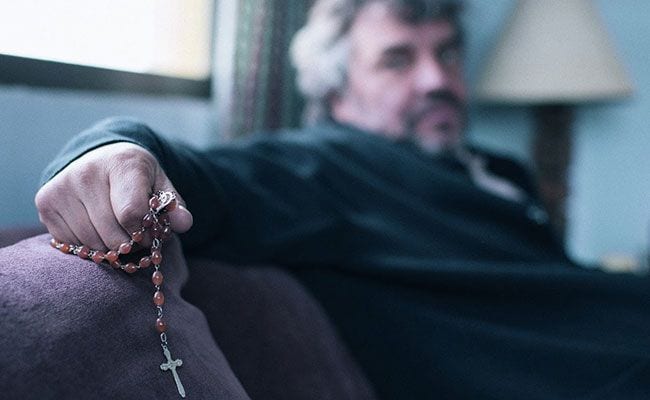
Chilean filmmaker Pablo Larraín is a man fired by conviction, something that seeps deeply into his work. His loose trilogy of sorts, which concluded with No (2012) looked at the Augusto Pinochet era from different angles. Now he’s put that to rest, a bigger target has entered his sights. The Club is an excoriating takedown of the Catholic Church and a howl of rage that soon turns into general despair when the same old patterns start to repeat themselves.
On the surface, it all seems so calm. In a tiny seaside town there’s a yellow house. From the outside, nothing looks unusual. It could be any house in any town. Except inside reside four disgraced priests (one played by Larraín regular Alfredo Castro), banished for eternity to this remote place for a litany of sins, child abuse among them.
They follow a strict routine of prayer and contemplation, overseen by a nun (Antonia Zegers), who is not entirely in favor of them, either. Only allowed into town at quiet hours, and never together, their one pleasure comes from greyhound racing. They train up and dote on a winning dog.
Inspired by an article about an exiled priest found living in such accommodation, this is Larraín laying open the Catholic Church approach to burying unpleasant problems. In a way it’s understandable. When God is the highest power, an organization worshipping such a supreme being doesn’t have to abide by anything as petty as the rule of earthly governments. Indiscretions, even illegal ones, are an internal matter.
Not everyone agrees with this approach, however. There’s a new Church and times they are a-changing. When another priest arrives, he’s immediately followed by Sandokan (Roberto Farías), a damaged man abused by the newcomer. The ensuing showdown ends badly, and after a stream of blood has been washed away, Father García (Marcelo Alonso) enters. Sent to investigate, he’s calm, collected and ruthless, and he wants to shut down these houses, places he sees as abominations.
The narrative spine of The Club follows Father García’s efforts to discover what really happened when Sandokan turned up. He interviews each member of the household and dives into their lives, gradually removing home comforts. There’s to be no more wine, and no more good times. The greyhound will have to go. Priests can’t be gambling, after all.
In such a murky environment, clear distinctions between right and wrong quickly become lost. An opening passage from Genesis discusses light and dark. Neither is present here, or to be precise, both are mixed in to a degree that remains unclear. To emphasize this, The Club, not the most visually arresting of experiences, is a hazy proposition. Everything has a washed out, faded look. Colors are indistinct and backgrounds have little life. It’s as if it all takes place on a grey, misty day.
The external world copies the personal as Father García discovers when his interrogations turn up a lot of denial. With the exception of one of the quartet, clearly senile, the rest seem to know what they did, but don’t accept it was necessarily wrong. Even their overseer has a dark past she flatly denies. Father García is as interested in getting some form of contrition from them as he is in uncovering what happened. But that’s not really his task, anyway. He’s travelling around trying to close down these places, stains on the honor of the Catholic Church, and undeserved retreats for people deserving of harsher punishment.
Not that anything is that clear in The Club. Heroes don’t line up against villains. The flawed face down the even more flawed. Then there’s Sandokan, the direct result of the kind of extraneous activities the Church wants to keep out of sight. He’s only barely able to function, left the rest of the time to recount graphic abuses suffered at the hands of errant clergy. No one wants to help him. At best, the priest’s, and even Father García, want to move him on, away from drawing unwanted attention. A friendly arm might drape around his shoulder, now and then, but the ultimate aim is to push him away.
As Father García delves deeper into this little world, he moves further from the fresh face of the Church he initially presents himself as. Sandokan becomes a problem, one he can utilize to rid this torrid place of many other vices, as well. In a devastating sequence near the end, a series of violent acts, playing out to Carlos Cabezas’ chilling score, build on top of each other. It leaves Father García plunging into the world he originally meant to eradicate, willing to sacrifice innocents for the cause.
The Club isn’t happy viewing, and it certainly isn’t an easy watch. Larraín exposes a quiet hinterland where bad things are hidden to avoid anyone finding out about them. When fixing it becomes too risky, it’s the innocent who suffer, as always. This may be the new church, but there’s plenty of room left under the carpet yet.
For a new release The Club comes with a good selection of extras including audio commentary by Alfredo Castro and Antonia Zegers, an interview with Pablo Larraín and Zegers, excerpts from the film’s 2015 Berlin press conference, and a written essay by Jessica Kiang.


![Call for Papers: All Things Reconsidered [MUSIC] May-August 2024](https://www.popmatters.com/wp-content/uploads/2024/04/all-things-reconsidered-call-music-may-2024-720x380.jpg)



